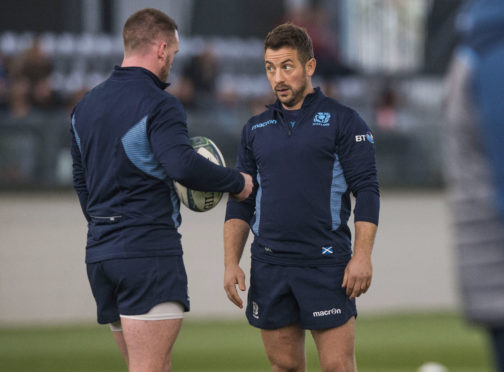An open running game is “in the genetics” of the Scotland team now, believes Greig Laidlaw, but we’re likely to see a sanitised version of the all-signing, all-dancing Scotland as they return to BT Murrayfield after a seven-month gap.
Fiji, today’s guests in the second Autumn Test, revel in an open game – they score nearly two-thirds of their points from turnover ball when the average in world rugby is less than a third – are not the team you want to be too free and unstructured against. It is surely time for Scotland’s Plan B, and the acknowledged leader of that – even when he hasn’t been captain – is Laidlaw.
It’s been 18 tests since Laidlaw was skipper but every time he is in the team he is a fulcrum of the way the team plays. Sometimes he’s simply a facilitator, but on occasion – the games against France and Italy in this year’s Six Nations spring to mind – he’s the fully-fledged, on-field director.
On both those occasions in the spring, the mercurial Finn Russell was hooked early and Laidlaw switched from scrum-half to stand-off to pilot the team to comeback victories playing a much more restricted, forward-based style.
This is exactly what will be required against Fiji, as the way to frustrate them is to keep them from the ball they love to run with so much.
“Keep the ball, that is one thing to do,” said Laidlaw. “They love running about and showing their skill sets but keeping the ball is one way, Just make them tackle, then tackle again. We have to just carry, clean, carry, clean.
“Make them do a lot of work, that is one of the areas we have worked on strongly this week.
“When we do attack we hold on to the ball. When we kick, we kick smartly and make sure we have a connected chase. Because in broken fields they are the best team in the world so we have to limit their opportunities.
“If we hold the ball we can test their discipline, keep going at them and try and frustrate them. Our forwards have a big job; if we can get a handle on the upfront game first and foremost that will give us an avenue into the game.”
Does it also mean reining in Russell’s attacking instincts? Quite apart from those two games in the spring, Finn was not as his best in the game exactly a year ago against the very similar Samoa, when Laidlaw was injured.
“You don’t want to rein him in too much,” said Laidlaw. “Sometimes, maybe. I’ll just give him a little look and I think he understands!
“In international rugby you’ve got to know, `when do we play, when do we not play?’ I think Finn’s got a better understanding of that now. Him moving away to France and the Top 14 will help him understand that.
“We’re not going to be able to run at Fiji for 80 minutes, that’s dangerous because there will be a couple of mistakes, and we want to limit that because we don’t want to give them turnover ball.
“We’ll certainly going to use our forwards and try to use them smartly, but we’re still going to try and shift the ball. That’s the genetics of this team now, we want to play quick rugby and we’re not going to go away from that.
“We want to use all areas of the field, but we need to be smart about that tomorrow. And when we do go (wide), we really need to execute.”
Both he and Russell get an extra frisson of excitement coming back to Scotland from France, continued Laidlaw, and he thinks playing for Racing will give Finn the boost to his career that he’s had since he went to Clermont.
“Since he’s settled in to Racing I think you can all see what a quality rugby player he is,” continued Laidlaw. “He’s going really well in the Top 14 as well as Europe and I certainly knew before he left Scotland that he’s a quality rugby player.
“But it’s up to Finn and myself essentially to control the game, and to do our jobs. I’ve got every belief in both of us that we can do that. “
Scotland have won eight of their last nine tests at Murrayfield, and the result is that every game, even Fiji – not a guaranteed draw in the past even if they’re one of the best to watch – is now a sellout.
There’s pressure to keep those fans entertained, but there’s also pressure to keep winning. For all that they’ve played seven tests in the interim, the last international at Murrayfield was the Calcutta Cup game, and it’s still first on everyone’s highlight reel.
Russell was the outstanding figure in that game, but a whole lot has happened to him in the interim. None of his swagger appears to have diminished in the Top 14, but as Laidlaw points out, he’s only ten games into his career with Racing.
The consistency with which he grabs games by the scruff of the neck – like against England – remains elusive. His performance against Samoa was his worst of the autumn last year, and his early removal from both the France and Italy games was probably pivotal in Scotland turning both games around.
Fiji are exactly the kind of opponent where Russell need to show his authority and play an all-round game, which he’s certainly capable of doing.
With Laidlaw and Pete Horne on either side of him as his minder/organisers, today’s a supreme test of whether Finn can actually be relied upon to run Scotland’s Plan B.


